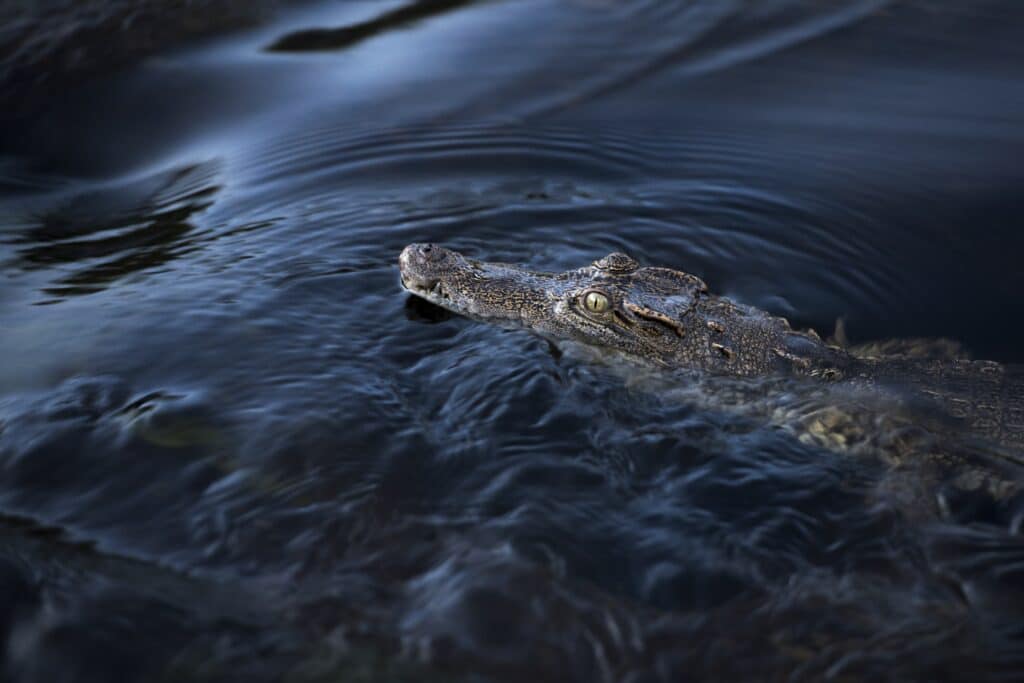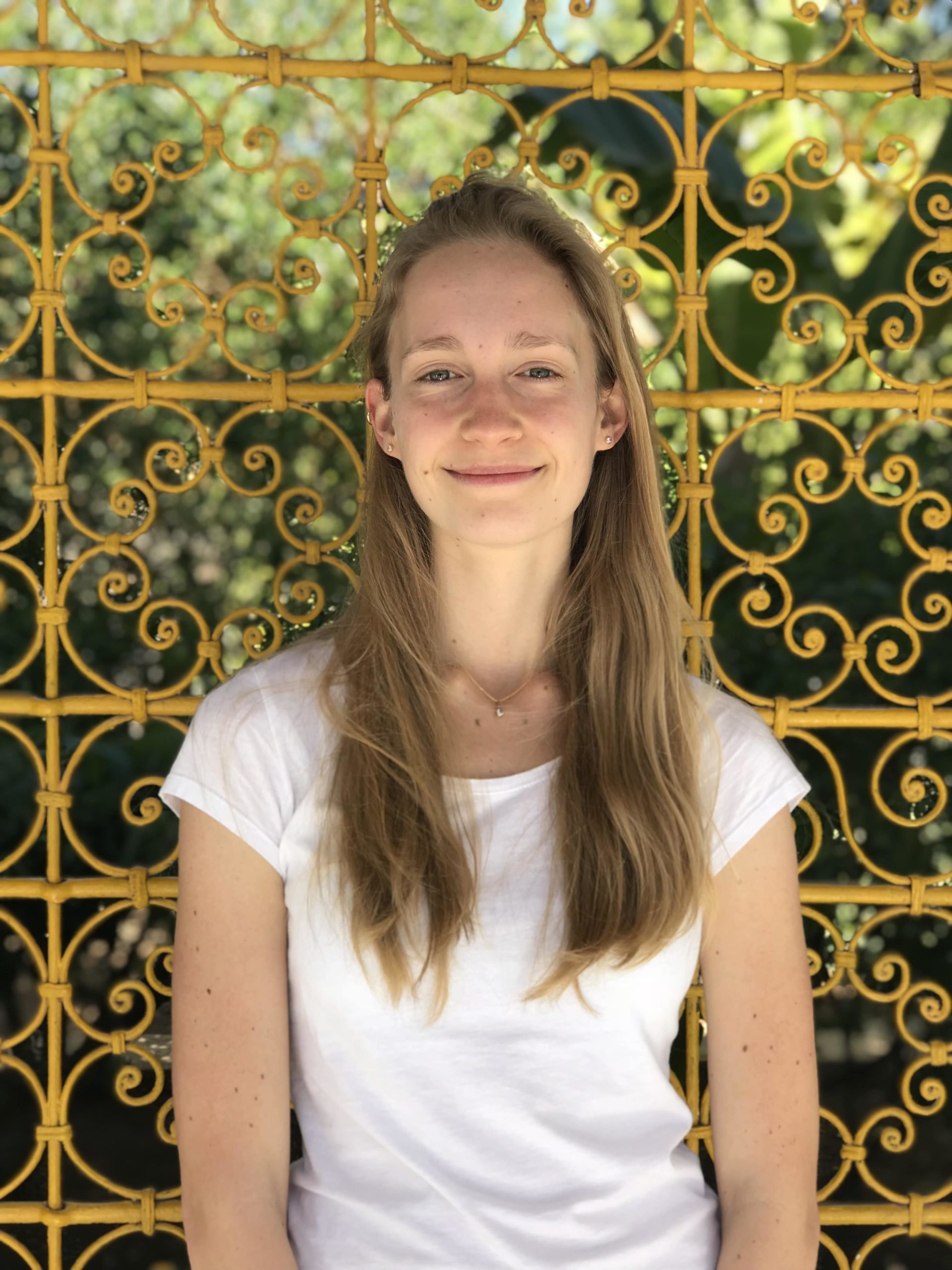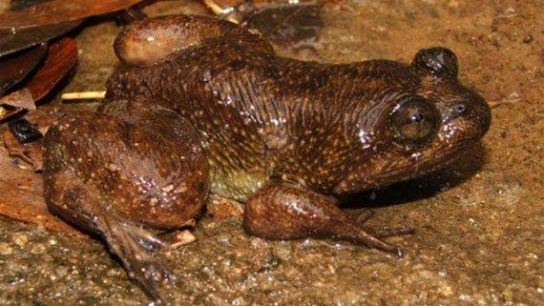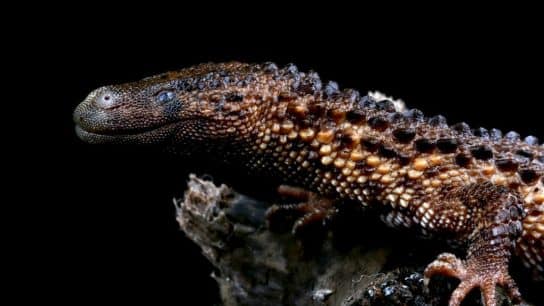The Siamese crocodile is amongst the most endangered reptiles in the world, with Cambodia holding the largest remaining wild population. One of 23 extant crocodilian species, the Siamese crocodile was once widely distributed across mainland Southeast Asia and Indonesia. However, in 1992, the species was reported to be virtually extinct in the wild due to commercial hunting practices and the collection of live animals to stock crocodile farms in the region. Since the rediscovery of approximately 200 wild Siamese crocodiles in the remote Cardamom Mountains of Cambodia in the year 2000, research into the ecology of the species has been conducted and a number of conservation measures have been implemented for its protection. Despite these efforts, the animal continues to be one of the least understood, rarest crocodilian species in the world.
—
Family: Crocodylidae
Genus: Crocodylus
Species: Crocodylus siamensis
IUCN Status: Critically Endangered
Population: 250 to 1,000 individuals in the wild
1. Appearance
The Siamese crocodile is a stocky, medium-sized freshwater species, with adult males typically reaching a length of 3.5 metres (11.5 feet) and females measuring around 2.7 metres (8.9 feet). The weight of adults ranges between 40 and 120 kilograms, with the largest male recorded reaching a length of 4 metres (13 feet) and a weight of 350 kilograms (771.6 pounds).
The species can be distinguished by prominent, bony crests behind each eye, a broad, smooth snout, and a row of four large post-occipital scales on its neck (typically used to distinguish Siamese crocodiles from saltwater crocodiles (Crocodylus porosus) in regions where both are found). With an olive to dark green colouration, the Siamese crocodile is well camouflaged in the mossy waters and rainforest habitats they hunt in.
In 2012, Paleobiologist Gregory M. Erickson conducted a study in which the bite force of all 23 crocodilian species were tested. Three specimens of Siamese crocodiles, weighing between 40 and 87 kilograms (88-192 pounds), were recorded as having a molariform bite force of 2,073 to 4,577 newtons. In contrast, the largest specimen of saltwater crocodile (Crocodylus porosus), weighing 531 kilograms, was found to have a bite force of 16,414 newtons. Hyenas, lions and tigers typically generate a bite force of around 4,450 newtons, and humans tear a steak with a bite force of 890 newtons. Interestingly, variations recorded in the bite forces of each crocodilian species correlated to differences in body mass; regardless of rostro-dental anatomy or diet, specimens of different species that shared similar body masses held similar bite forces.
In most animal groups, and as was previously believed for crocodilians, variations in bite force are a result in differing jaw shapes, tooth forms and diets. Yet, in light of the results of the study, Erickson noted: ”I think the most primitive development of the crocs was basically as a force-generating machine… Variations in snouts and teeth arose later, fine-tuning that powerful bite for prey ranging from fish and snakes to birds, mammals, and even insects.”
The study noted that one of the major factors in the evolutionary success of crocodilians was the retention of a specialised cranial musculoskeletal system that generates a bite force sufficient to capture a range of different prey opportunistically.

Close-up of a Siamese crocodile’s jaws at Phnom Tamar Wildlife Rescue Centre. Photo courtesy of Jeremy Holden for Flora and Fauna International.
2. Diet
Although the dietary preferences of captive Siamese crocodiles are well documented, the feeding habits of wild populations have been indefinably determined through faecal analyses conducted in Cambodia and Laos. While faecal analysis cannot be used to reliably quantify the relative importance of specific prey species for Siamese crocodiles, due to the varying digestibility of animal remains, the proportions of common prey (identified at a more general taxonomic level) found in each sample of faecal matter provide a good indication of feeding preferences.
Similarly to other crocodilian species, Siamese crocodiles are generalist predators that feed on a wide variety of animals, such as invertebrates, fish, amphibians, reptiles, birds, crustaceans, and mammals (including carrion). Contents of faeces analysed were comprised of 30.9% fish, 29.6% reptiles, 11.5% invertebrates (including ants, beetles, scorpions and crabs), 4.9% mammals, and 3% birds. Approximately 88.1% of the reptiles were identified as snakes, from their ventral scales. There was no indication of amphibian remains, although this is most likely because their bodies and bones were fully digested. As keratin structures (eg. hair, feathers, scales) and chitin (eg. arthropod exoskeletons) are excreted intact in crocodile faeces, researchers were able to identify the presence of mammal hairs consistent with rats or other species of rodents, as well as those of adult wild boar (although these were only located in the faeces of very large adults).
While it is clear that fish and snakes are of significant dietary importance to Siamese crocodiles, further studies are needed to quantify the amount of prey consumed by different crocodile age groups, as well as to identify crucial prey to a species level. Such fundamental ecological knowledge is essential for the creation and implementation of conservation strategies, as the protection of vital prey sources plays a critical role in their ability to reproduce and survive in the wild.
3. Habitat & Behaviour
The Siamese crocodile is a freshwater crocodile found primarily in slow-moving wetland habitats, such as swamps, rivers, lakes, marshes, seasonal oxbow lakes, and streams, from near sea-level to elevations of up to 600 metres (recorded in the Central Cardamom Mountains). Permanently-occupied sites were typically found to feature gently sloping banks, both open and heavily shaded areas, a surrounding forest, and waterbodies with a minimum depth (even during dry season) of 1.1 metres. During the wet season, Siamese crocodiles have been observed dispersing across flooded landscapes, with one radio-tracked individual having travelled 25 kilometres (15.5 miles) before returning to a dry season site. Adult Siamese crocodiles have also been observed constructing burrows, excavated into the banks of rivers and lakes, with up to five individuals utilising one burrow at a time. However the exact purpose of these burrows, or how the behaviour evolved, remains unclear.
Once widespread throughout mainland Southeast Asia and Indonesia, with historical records indicating the species’ presence in Cambodia, Laos, Malaysia, Myanmar, Thailand, Vietnam and Indonesia, the Siamese crocodile has since disappeared from approximately 99% of its former range. Remnant populations are greatly diminished and fragmented, consisting mainly of scattered individuals confined to small, degraded waterbodies in remote areas in Cambodia, Indonesia, Lao, Thailand and Vietnam. Many sites where crocodiles were reportedly observed prior to 2000 were either devoid of the species, or contained only one or two isolated individuals with no signs of breeding occurring; very few colonies are confirmed to be reproductively active. Field studies and interviews conducted across Cambodia revealed that the majority of sites with confirmed Siamese crocodile populations were state forestlands in the Cardamom Mountain range. Located at elevations of up to 600 metres, these significantly cooler sites are believed to be marginal habitat for the species, associated with slower growth and reproductive rates when compared to larger, warmer bodies of water in lowland regions.
Despite conservation concerns, very little is known about the behavioural and reproductive habits of the Siamese crocodile. Like most crocodilian species, they are believed to be primarily nocturnal hunters, utilising daylight hours to rest and bask in the sun (since crocodiles are reptiles, they rely on their environment to regulate their body temperature, often seen sunbathing with their mouths open to prevent their brains from overheating). Able to remain submerged beneath the water for over an hour, crocodilians have certain physiological adaptations, such as a specialised heart and metabolic system, that enable them to hunt aquatic prey or catch birds by surprise.
Crocodilians have a small opening within the outflow tract of the heart between the left and right aorta called the Foramen of Panizza, which allows blood to bypass pulmonary circulation (since there is no oxygen in the lungs to oxygenate blood, pulmonary circulation becomes an unnecessary use of energy when submerged). Crocodiles will reduce their heart rate to two to three beats per minute, saving energy in the form of reduced cellular respiration and only sending oxygen-rich blood to the areas of the body that need it most. If a crocodilian then needs to carry out strenuous physical exertion, such as lunging out of the water to capture prey after having been submerged for an extended period of time, they utilise anaerobic respiration, deriving energy from glycolysis when musculature cells have no oxygen left.
The Siamese crocodile is not considered to be an aggressive species, with only three to five reported attacks on humans in the past century (all of which were defensive and not fatal). Communities that reside in close proximity to the species’ habitat continue to bathe and swim in waterbodies where crocodiles are known to hunt. This is particularly true of areas occupied by indigenous Cambodian communities, such as in the Cardamom Mountains, which hold the largest remaining colonies of Siamese crocodiles. Certain ethnic minority groups believe that crocodiles hold a spiritual significance and bring good luck, and that killing or disturbing the animals could bring misfortune.
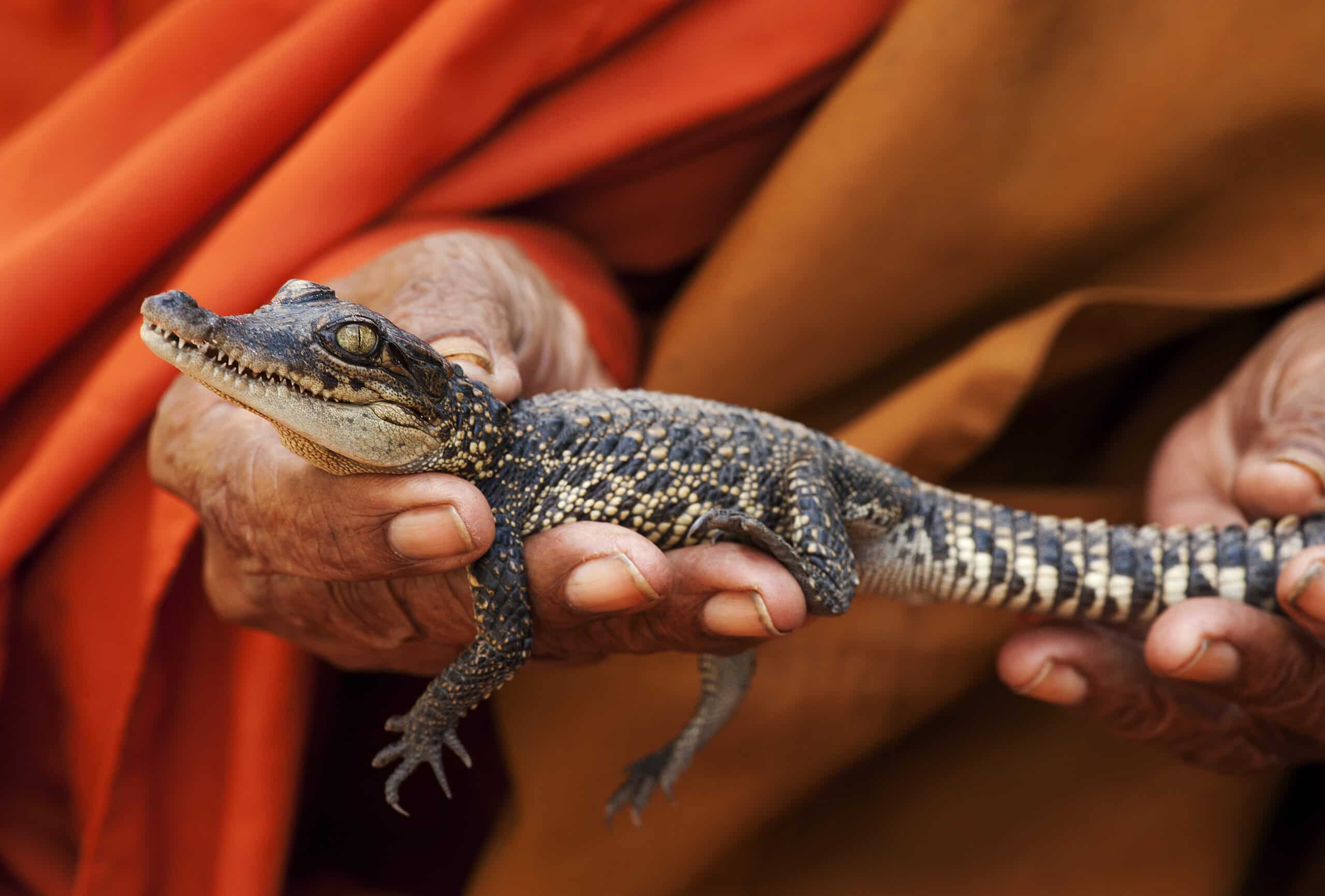
A baby Siamese crocodile being handled in Cambodia. Photo courtesy of Jeremy Holden for Flora and Fauna International.
Female crocodiles construct mound nests, scraping together mud and vegetative debris, on floating vegetation mats, on the banks of rivers or lakes, or in deeply shaded areas under thick tree canopy. Fidelity to nesting sites has been observed in the wild. Nesting occurs towards the end of the dry season (March to April), with females producing 11 to 26 eggs (captive females have been reported to produce clutches of six to 50 eggs). Females will generally remain close to the nest during incubation; some reports noted aggressive nest defence by the mother (as well as by the father when in captivity), whilst others observed wild adults immediately fleeing when approached by humans, even if their eggs were handled and their offspring emitted alarm calls. After an incubation period of 70 to 80 days, during which temperature-dependent sex determination occurs, hatchlings are born in the wet season (May to June).
Less than a few dozen wild nests have been located to date. In one study, observing the fate of 14 Siamese crocodile nests, researchers observed that five nests were poached (36%), one was raided by animals (7%), two were destroyed by flooding (14%) and the remaining six hatched successfully (43%). Further monitoring of 23 hatchlings, located in a well-protected lake in the Areng Valley of Cambodia, revealed that only five (22%) survived their first year of life. This extremely low level of reproduction is not enough to maintain wild populations, given the fact that many anthropogenic pressures threatening both juvenile and adult Siamese crocodiles remain present in the species’ primary habitats.
Since the scientific community became aware of the plight of Siamese crocodiles, research on the ecological and biological background of the species has increased, although opportunities to examine wild populations are limited. Further studies have been conducted on the species’ phylogeography and population genetics, seasonal sperm cycles, as well as on the potential antimicrobial properties of their blood. Since the vast majority of captive Siamese crocodiles are actually hybridised (bred with Cuban crocodiles, Crocodylus rhombifer, and saltwater crocodiles, Crocodylus porosus), researchers and conservationists have also successfully identified the chromosome number of pure Siamese crocodiles and their hybrids, as well as DNA methods to distinguish the two.
4. Ecosystem Services
Although there is limited knowledge on the ecological background of Siamese crocodiles, the generalist diet of the species indicates that it plays a crucial role in population control within their ecosystem; regulating the abundance of prey species, preventing the degradation of their environment and maintaining clean waterways. Siamese crocodiles also create habitats for other species by building nests and excavating burrows, and further protect aquatic life during the dry season by preventing the exploitation of water supplies by terrestrial animals.
Since the majority of remaining Siamese crocodile populations are found in protected wetland habitats, efforts aimed at conserving the species inherently protect a myriad of other animals and vegetation that depend on the vitality of these habitats for their survival. Peat bogs, freshwater lakes and other wetlands also act as important natural carbon sinks, which aid in the mitigation of climate change by absorbing carbon dioxide from the atmosphere, so the preservation of such ecosystems is crucial not only for the future of Siamese crocodiles, but also for the overall health of the planet.

A young Siamese crocodile in a river, Chhay Reap, Cambodia. Photo courtesy of Jeremy Holden for Flora and Fauna International.
5. Threats
The Siamese crocodile is considered to be one of the most threatened crocodilian species in the world. It is widely believed that the rampant commercial hunting of Siamese crocodiles that commenced in the mid- to late-20th century, for the international skin trade and to stock crocodile farms across southeast Asia, were the primary causes for the decimation of wild populations. Competition with rice farmers for suitable wetland habitats also contributed greatly to the fragmentation of colonies. In 1992, the species was reported to be virtually extinct in the wild, and in 1996 was labelled as ‘Critically Endangered’ by the International Union for Conservation of Nature’s Red List since scientists, although not entirely certain of the exact rate of decline, were confident that global populations had been reduced by more than 80% over the preceding three generations. Today, poaching, habitat loss, incidental entanglement in fishing gear, and inherent vulnerabilities associated with a highly diminished, fragmented remnant wild population continue to threaten the future existence of the Siamese crocodile.
The capture of Siamese crocodiles for commercial crocodile farms has been ongoing since the 1940s. The fact that the species is relatively placid, easy to breed in captivity, has the capacity to grow to a considerable size and produces fine, soft leather has made Siamese crocodiles a prime target for crocodile farmers who sell the animals live, for their meat and skin. Despite being listed under Appendix I of the Convention on International Trade in Endangered Species of Wild Fauna and Flora, Article VII Paragraph 4 of the Convention states that “specimens of an animal species included in Appendix I bred in captivity for commercial purposes shall be deemed to be specimens of species included in Appendix II”. Consequently, Siamese crocodiles bred in commercial farms can be traded internationally subject to licensing controls.
Initially stocked from Siamese crocodiles illegally caught in the wild and subsequently propagated artificially, there are now an estimated 1.53 million captive Siamese crocodiles in commercial farms across Cambodia, Thailand, Vietnam and China. However, this figure does not account for all hybridised crocodiles, as farmers typically breed Siamese crocodiles with saltwater and Cuban crocodiles, producing larger offspring. In Cambodia, there are approximately 445 registered crocodile farms, although conservationists estimate there are over 900 farms in operation. Of those registered, only 21 have been approved under CITES to export the animals internationally. Vietnam and Thailand are believed to operate over 1,000 farms each, of which 28 in Thailand and 10 in Vietnam are CITES-registered. Crocodile farming accounts for approximately 1% of Thailand’s yearly agricultural income. From 2013 to 2022, roughly 1,993,424 Siamese crocodiles were exported from farms holding CITES licences. The vast majority were imported by Hong Kong and China. Of those nearly two million specimens, 828,839 were sold as meat products, 447,418 were sold live, 336,622 were skins, 191,832 were pre-made leather products, and 79,410 were entire, deceased bodies.
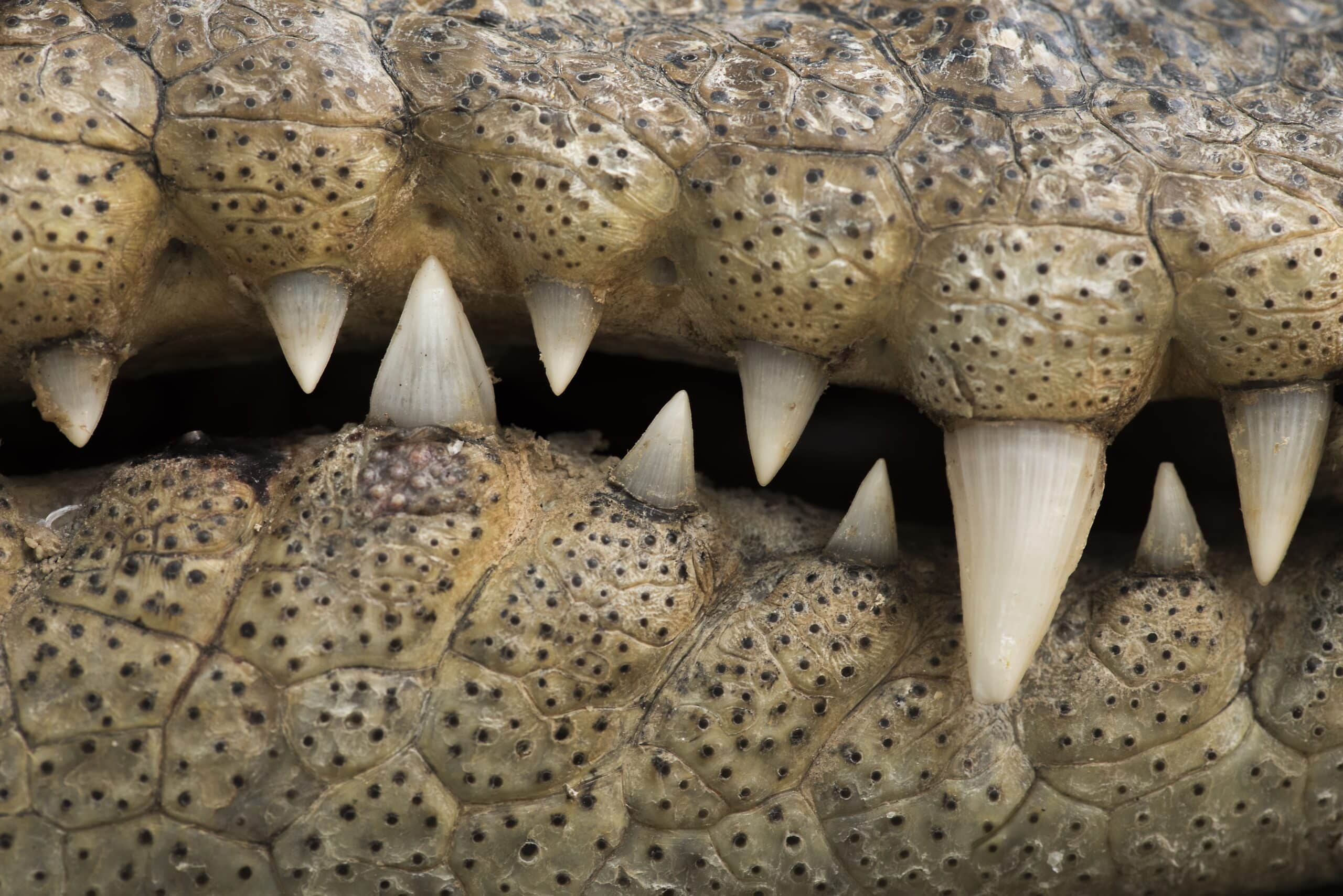
Close-up of a Siamese crocodiles skin. Photo courtesy of Jeremy Holden for Flora and Fauna International.
The existence and apparent legality of the international trade of Siamese crocodiles and products derived from their body parts, as well as the extremely high economic value of the trade, is an undeniable incentive for the illicit capture of wild specimens by traders, poachers, and even park rangers in impoverished countries. Leather products and suits produced from Siamese crocodile skin are worth up to US$5,894, blood and bile (believed to hold health benefits) can be sold for up to US$1,167 per kilogram, and meat can fetch up to US$8.76 per kilogram. CITES are aware that on countless occasions Siamese crocodiles traded internationally were sourced from wild populations, having reported the export of 242 wild specimens in 2020 alone. With an estimated 250 to 1000 individuals remaining in the wild and categorised as a critically endangered species, the export of even a single wild specimen, which can never be obtained legally due to national legislations, would logically be considered a detriment to the survival of the species and should warrant the cessation of all legal trade of the species. The industry surrounding the exploitation of Siamese crocodiles is an example of the ineffectiveness of CITES and its lack of conservation value in certain cases, prioritising profit over the protection of a critically endangered species, as the regulations imposed by the Convention have failed to have an impact on the decline of Siamese crocodiles in the wild over the past 50 years.
Apart from farming and international trade, local consumption of Siamese crocodile eggs, hatchlings and adults continues in Vietnam, Cambodia and Indonesia, although reporting on such instances is limited due to the lack of legislative enforcement in remote areas.
In the 20th century, the effects of anthropogenic pressures on primary Siamese crocodile habitats also increased dramatically. Apart from the impacts of warfare in Vietnam, Laos and Cambodia, during which land mines, aerial bombardment and the use of chemical agents severely degraded natural ecosystems, the species faced growing competition from agricultural farmers for suitable wetland habitats. Rapidly growing human populations in key range states resulted in the conversion of wetlands for rice, crop and cattle farming, further accompanied by the use of chemical fertilisers and pesticides, the removal of aquatic vegetation, and seasonal pumping of water for rice irrigation. In turn, Siamese crocodile populations faced increased exposure to human conflicts as key prey sources were depleted, historical nesting sites were degraded, and primary habitats were destroyed and fragmented.
Aside from subsistence-level farming, the granting of economic land concessions in key range states has resulted in the conversion of wetland and adjoining habitats for rubber, palm oil, and banana plantations, as well as mining operations. At present, a mere 11% of remaining Siamese crocodile habitats are found within national protected areas, and even these are still at risk of economic exploitation. Approximately 70% of Lake Mesangat, East Kalimantan, which is considered to be an essential ecological area for Siamese crocodiles in the region, has been converted for palm oil production, with water diversion having grave effects on the hydrological conditions of the remaining habitat.
River systems across Cambodia, Vietnam and Myanmar, including those found within supposedly protected areas, have also been targeted for dozens of large-scale hydroelectric dam projects. The construction of these dams has already resulted in the mass loss of breeding habitat due to the alteration of flooding cycles, with a 50% increase in dry season flows when compared to natural conditions. In 2006, the Vietnamese government approved the construction of a hydro-electric dam at the Ha Lam Lake in Phu Yen Province, which was the last known site to support wild Siamese crocodiles in Vietnam (the species was considered to have been extirpated from Vietnam as a consequence). The construction of new roads and the influx of construction workers to work on such projects also threatens the safety of wild populations; in 2011, forestry rangers in Cambodia reported finding a young wild Siamese crocodile in the possession of Chinese workers hired to construct the Steung Atay hydroelectric dam in Koh Kong Province. The section of the Mekong River known as the “Golden Triangle”, where the borders of Thailand, Myanmar and Laos meet and which potentially holds remnant Siamese crocodile populations, has also been heavily impacted by illegal blasting to deepen the channel for shipping activity.
Although conflicts between humans and Siamese crocodiles rarely arise in the wild, due to the fact that the species is known to be mild natured and fearful of humans, instances of crocodiles interfering with fishing activities or preying on livestock have resulted in crocodile fatalities and human injuries in the past. As fishing is widely considered to be an essential source of sustenance and livelihood for rural communities, the practice tends to occur in most waterways across Cambodia, in remnant crocodile habitats in Indonesia and Myanmar (such as Mesangat Lake and sections of the Mekong River), and even in protected areas that prohibit the catch of fish, frogs or aquatic animals. Despite prohibitions on highly destructive fishing methods, such as electrofishing, spear-fishing, and the use of explosives or poisons, such practices are still carried out in remote areas where law enforcement is limited and these often have devastating consequences for crocodile populations, as well as their prey stocks and habitats. Lawful fishing methods, such as the use of gill nets, can also result in crocodiles becoming entangled and drowning, particularly due to the fact that most fishermen now utilise nylon nets (as opposed to nets made from natural fibres), which are harder for crocodiles to break free from. Fishermen have reported on past instances of receiving injuries from entangled crocodiles that they attempted to set free, and others detailed cases in which Siamese crocodiles were killed by fishermen or hunters for having preyed upon hunting dogs, livestock, or fish (which the species must inevitably must compete with fishermen for).
Decades of aforementioned anthropogenic pressures have consequently led to an extremely depleted, fragmented remnant population of wild Siamese crocodiles, which presents a number of additional threats to the future survival of the species. Sudden natural disasters or stochastic hazards can cause mass or complete population declines, particularly given the increasing frequency of unpredictable climatic events due to climate change. Inbreeding and loss of genetic diversity, which result in offspring with lower fertility and reduced resistance to disease or climactic changes, further render the species vulnerable to extinction. Radiotelemetry studies of Siamese crocodiles in the Cardamom Mountains have indicated that the species is highly sedentary, and therefore even in habitats that are not fragmented and that possess vacant waterways, individuals from differing genetic populations may never meet and breed. Nests of non-viable and presumably infertile eggs have been reported in Thailand and Laos, indicating that remaining colonies suffer from limited reproductive success and possibly a paucity of males (given that crocodile embryos require lower temperatures to hatch as males). There are a number of animals, such as wild boar, monitor lizards, and macaques, which prey on the eggs of crocodiles, whilst juveniles are often consumed by lizards, snakes, storks and large wetland predators. Although studies on the subject are limited, data collected suggests that approximately 40% of clutches succeed in hatching, and roughly 22% of hatchlings survive their first year. Adult Siamese crocodiles do not have any natural predators, but instances of saltwater crocodiles attacking Siamese crocodile have been reported where territories overlap.
Lastly, the widespread hybridisation of Siamese crocodiles in farms and zoos across key range states poses a threat to the genetic integrity of wild Siamese crocodiles, as any hybrids that are released or that escape into the wild can potentially breed with genetically pure specimens. Although hybrid offspring are fertile, they behave more aggressively than pure-bred Siamese crocodiles and could harm public perceptions of crocodiles within rural communities. The threat of unregulated releases of hybrids has intensified in recent years due to the decline in demand for crocodile skin, together with increasing costs in maintaining farms, as many farmers have reported a desire to sell their farms and seek alternative sources of livelihood. Although scientists have successfully identified the chromosome number of pure Siamese crocodiles and their hybrids, and have further developed DNA methods to distinguish the two, these can only be used to ensure government-sanctioned releases are genetically pure specimens and does not prevent uncontrolled releases from cross-breeding.
6. Conservation
Once Fauna and Flora International, in collaboration with the Cambodian Government’s Forestry Administration, confirmed the existence of wild Siamese crocodiles in the Cardamom Mountains of Southwest Cambodia in 2000, surveys and conservation strategies were gradually implemented across the species’ remaining range states in a final attempt to save the Siamese crocodile from extinction in the wild. Although there is still an immense amount of work to be done to recover wild populations and their natural habitats, recent successes in Cambodia, Thailand, Vietnam and Laos are a promising first step in the conservation of one of the rarest crocodilian species in the world. Conservation priorities have primarily focused on: status surveys; the development of management and conservation programmes; re-introduction and re-stocking initiatives; community outreach and engagement campaigns, and scientific research.
As the exact number of wild Siamese crocodiles remaining in each key range state was entirely unknown at the turn of the 21st century, conservation initiatives commenced with status surveys to obtain quantitative estimates of population sizes, as well as the identification of any remaining strongholds, key habitats and breeding sites.
With observations of remnant wild Siamese crocodile populations having indicated low breeding success, infertility and the possibility of male paucity, conservation efforts focused greatly on the protection of suitable wetland habitats, breeding sites, and the reduction of poaching instances through community-based initiatives. The Government of Cambodia’s Forestry Administration, with immense support from Fauna & Flora International (FFI), has been at the forefront of Siamese crocodile conservation with the establishment of a long-term Cambodian Crocodile Conservation Programme (CCCP). The programme has succeeded in training rangers to conduct patrols of protected areas, monitoring and protecting key breeding sites, establishing community-based conservation management initiatives, and creating sanctuaries in northeastern Cambodia. In March 2020, ten baby Siamese crocodiles were reported in the Veal Veng Marsh, a protected area managed by FFI, demonstrating the success of such habitat protection initiatives. FFI further works with a network of local communities, such as the indigenous Khmer Dauem in the Cardamom Mountains, to improve their food security, their business acumen and their capacity to conserve their cultural heritage.
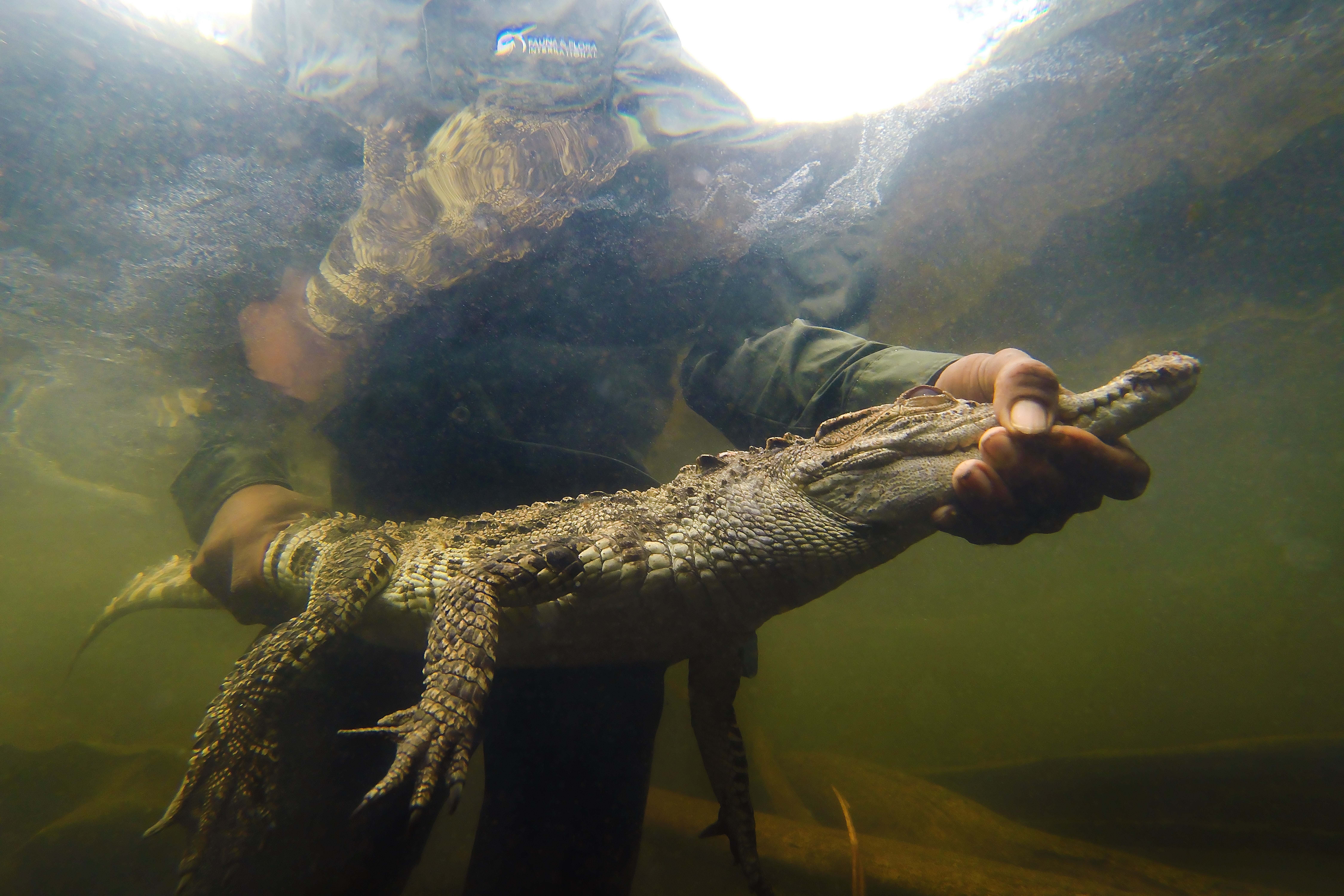
The release of a Siamese crocodile. Photo courtesy of Jeremy Holden for Flora and Fauna International.
The Cambodian Ministry of Environment has further partnered with the World Wildlife Fund (WWF) in protecting the Srepok and Phnom Prich Wildlife Sanctuaries – two historical Siamese crocodile sites. Through this strategic, long-term partnership, WWF and the Cambodian Government have succeeded in safeguarding the two sanctuaries by conducting monitoring and research on the biodiversity of the localities, building the capacity for stricter law enforcement in the areas to prevent poaching, logging and land encroachment, and through community engagement initiatives aimed at promoting sustainable sources of livelihood and natural resource management. In September 2021, their efforts were realised when eight baby Siamese crocodiles were found in Sre Pok Wildlife Sanctuary for the first time in decades.
The establishment of eco-tourism initiatives has also helped safeguard key regions in the Cardamom Mountains of Cambodia. Apart from private enterprises, such as the Bensley Collection, international organisations have teamed up with local groups in order to purchase economic land concessions from the government in the Cardamom Mountains to establish community-based tourism projects. These initiatives, operated by organisations such as the Wildlife Alliance, not only protect large areas of forest from being destroyed and converted into palm oil plantations or exploited for timber production, but also provide local communities with alternative, sustainable sources of income that encourage environmental conservation. Since governments in developing countries are typically unable to afford resources for the effective management and protection of natural parks, eco-tourism projects assist in conserving ecosystems by managing these areas sustainably. In the Areng Valley of Cambodia, a critical remnant habitat for wild Siamese crocodiles, the proposal of an hydroelectric dam project was successfully halted by local communities in 2014 after Areng-based NGO Mother Nature Cambodia began mobilising a campaign to resist construction and educate locals on the importance of environmental protection and its potential as a long-term source of livelihood.
In Lao PDR, the Wildlife Conservation Society (WCS) initiated a programme in 2008 focused on community-based conservation approaches, as the majority of remnant wild Siamese crocodile populations are located outside the boundaries of protected areas in the country. Community workshops were conducted to gain an understanding of local sentiments towards crocodiles, and to determine the feasibility of community-based tourism focusing on the conservation of the animal. WCS succeeded in establishing Village Crocodile Conservation Committees to lead wetland protection initiatives, as well as a programme to conduct participatory land-use planning to limit habitat encroachment and exploitation. Core crocodile conservation areas have been designated within Ramsar sites (Wetlands of International Importance), with seven local villages participating in the project, and the Government has indicated plans to develop management strategies for the continued protection and eventual expansion of suitable crocodile habitat. In Indonesia, the palm oil company that currently owns Mesangat Lake entered into a partnership with Yayasan Ulin (The Ironwood Foundation), a local conservation organisation, with the intention of jointly managing and conserving important wetland habitat that contains remaining Siamese crocodiles in the region. Thailand currently supports the most effective, well-developed network of protected areas of any Siamese crocodile range state, and thus has the potential to be at the forefront of recovery efforts for the species. However, initiatives in the country have been slow to commence.
Re-introduction and re-stocking initiatives have also proven successful so far in Cambodia, Thailand, Laos and Vietnam. As the Siamese crocodile is comparatively placid and unthreatening to humans, the species has the potential to cohabitate with local communities in the wild. By first ensuring that captive-bred specimens are genetically pure Siamese crocodiles, and by further confirming that areas intended for releases (primarily well-protected waterways) are largely devoid of hunting, persecution and other potential threats to the species, programmes across the range states have resulted in high rates of survival, promising breeding successes and positive responses from local stakeholders and communities. Advances in genetic testing and satellite tracking of released individuals have further streamlined these initiatives. Under the Cambodian Crocodile Conservation Programme (CCCP), the Phnom Tamao Wildlife Rescue Center established a breeding programme in 2010 in collaboration with Fauna & Flora International (FFI). Since 2012, the programme has successfully released 136 crocodiles in the Cardamom Mountains, and a further 179 pure specimens are currently in captivity in the Phnom Tamao Zoological Park. In 2022 conservationists expanded the range of re-introduction programmes beyond the Cardamom Mountains to the Siem Pang Wildlife Reserve in northern Cambodia, where the species were historically found but were ultimately extirpated from. Organised by local conservation group Rising Phoenix, the release presented greater challenges as local communities were wary of a species they had not cohabitated with in decades. After months of assuaging local concerns, 15 Siamese crocodiles were introduced into wetland channels in the Reserve, and plans for the release of a further 20 crocodiles at a nearby site are underway. Although unsure of the effects of reintroducing an apex predator to an ecosystem that it has been absent from for a substantial period of time, the campaign to save Siamese crocodiles from extinction in the wild is seen by conservationists as an ecological necessity.
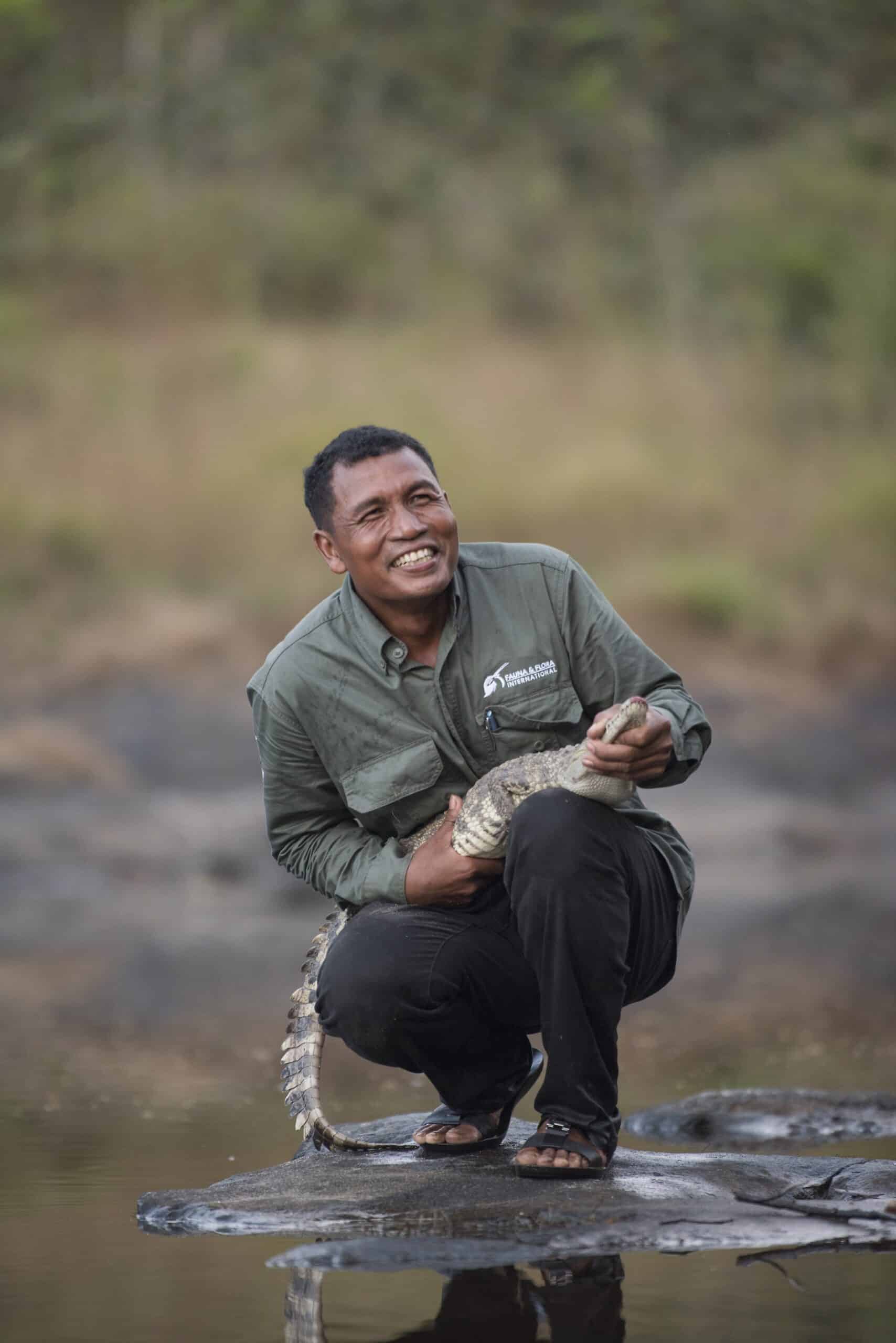
Head Warden, Sim Khmao releasing a Siamese crocodile at Chhay Reap, Cambodia. Photo courtesy of Jeremy Holden for Flora and Fauna International.
Between 2005 and 2006, the Royal Thai Forest Service and Crocodile Management Association of Thailand successfully released 20 Siamese crocodiles in Pang Sida National Park. Although severe flooding in 2011 greatly hindered plans for further releases, conservation groups believe that the re-establishment of viable populations of crocodiles in protected areas is still feasible. In Lao PDR, the Wildlife Conservation Society (WCS) began working with the local government in 2011 on a programme to breed and release Siamese crocodiles, which culminated in the hatching of 20 specimens at the Laos Zoo. After their release in 2013 to 2014, surveys conducted in 2018 strongly suggested that wild populations were growing. A community-based programme for egg collection and head-starting juveniles was also implemented at several villages in Savannakhet Province, Lao PDR, between 2008 and 2013, resulting in the return of 65 head-started juveniles to the wild in 2014. Aforementioned surveys in 2018 indicated high survival rates amongst these returned crocodiles. In Vietnam, 60 captive-bred Siamese crocodiles were re-introduced to Bau Sau Lake in Cat Tien National Park between 2001 to 2004, and one nest was reported in 2005. Although subsequent monitoring suggested that 25% of the released population was killed by local residents in 2004, hatchlings and juveniles were observed in 2009, which confirmed that remaining adults were breeding successfully. By 2010, the re-introduced population had risen to 100 to 150 crocodiles, however poaching for local consumption continues to pose a significant threat to the species’ survival in the region.
Concerns with the continued commercial farming of Siamese crocodiles have been widely debated, as many argue that the lack of effective governance and monitoring in key range states results in farms working to the detriment of wild populations. Although the commercial trade of wildlife can contribute to the recovery of wild populations when following a ‘sustainable use’ model, as demonstrated by Australia’s saltwater crocodile industry, crocodile farming in Southeast Asia was built upon and continues to be driven by financial gain, devoid of any forward-thinking research or conservation considerations, and has expanded exponentially without regulation. Nevertheless, due to its critical importance for the economic vitality of communities within range states, conservationists have proposed developing strategies to work with the crocodile farming industry, mobilising and channelling its powerful economic force for the benefit of conservation and the survival of wild Siamese crocodile populations.
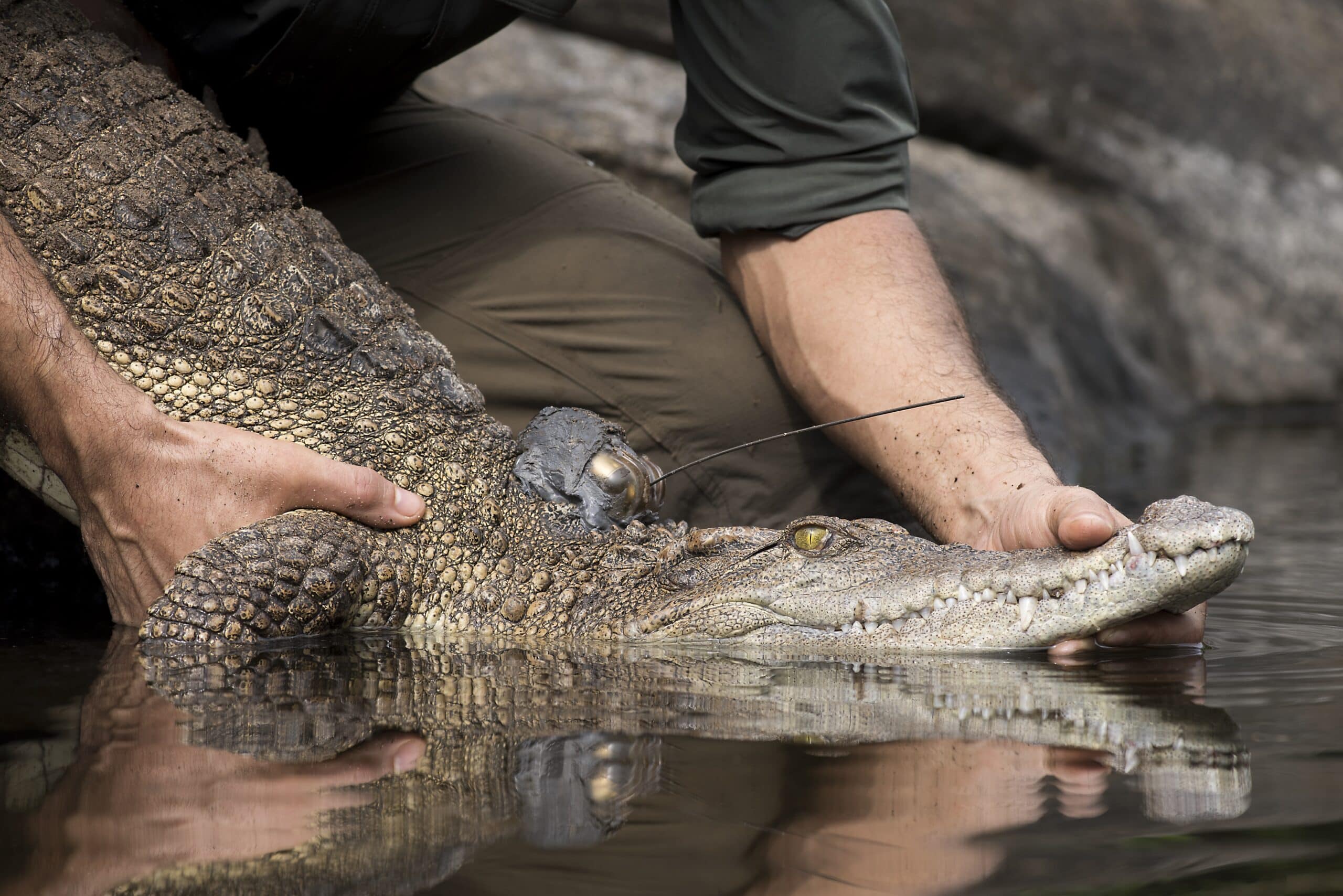
A satellite tagged Siamese crocodile ready for release, Chhay Reap, Cambodia. Photo courtesy of Jeremy Holden for Flora and Fauna International.
As captive-bred crocodiles held across numerous farms in key range states have been genetically tested and confirmed to be pure Siamese crocodiles, these populations represent a potential source of specimens for re-introduction programmes. This is particularly true of Thailand, where a reservoir of genetically pure Siamese crocodiles is present on commercial farms across the country. The Thai Crocodile Farmer Association, in collaboration with the Department of National Parks, Wildlife and Plant Conservation and Mahidol University, have indicated that the Association plans to release a small number of commercially-bred Siamese crocodiles in Pang Sida National Park every year from 2023. In Cambodia, Flora and Fauna International (FFI) has partnered with several crocodile farmers interested in the conservation of the species, highlighting the importance of farm donations as a source of head-started juveniles or adults that can quickly build up wild populations and diversify the gene pool. Farmers have donated approximately 300 crocodiles to the re-stocking programme, and roughly one third of the specimens released in Cambodia so far have been from commercial farms. While considerable conservation efforts are still required for the recovery of the species in the wild, Siamese crocodiles are widely believed to have a reasonable chance of survival.
NGO Spotlight: Flora and Fauna International
As aforementioned, Flora and Fauna International (FFI) have been at the forefront of Siamese crocodile conservation in close collaboration with the Cambodian Government. In addition to supporting re-introduction and re-stocking initiatives with the Phnom Tamao Wildlife Rescue Center, FFI recognises the importance of working with local communities to mitigate potential threats to wild Siamese crocodile populations by supporting the needs, beliefs and practices of locals. After conducting consultations with locals, FFI established three community-managed sanctuaries to protect the most prosperous breeding colonies in the wild, all of which have become nationally protected under the Ministry of Environment. Further management plans for new protected areas are in the process of development.
FFI also initiated discussions with local communities, such as the indigenous Khmer Dauem, on the issues they face and understanding how these may impact wildlife populations. They then established a programme with three main strategies to address the needs of locals and achieve outcomes that are mutually beneficial for their surrounding environment. Firstly, for greater food security and the introduction of alternative sources of protein (besides fish, which depletes prey sources for crocodiles and threatens net entanglement), FFI provides technical training on rice and chicken farming with a focus on sustainable community participation. Secondly, to boost incomes and strengthen market systems for such isolated communities, FFI improves the business acumen of locals and introduces monitoring and patrolling as potential alternative sources of livelihood. Lastly, FFI focuses greatly on building the capacity of communities to protect and conserve their environments, having assigned 31 community wardens to patrol five community-managed crocodile sanctuaries across the Cardamom Mountains. Wardens are extensively trained and tasked with raising awareness about the importance of safeguarding crocodiles and the regulations in place to protect them, gathering information about crocodiles they observe, understanding local attitudes towards the species, and reporting any threats or illegal activities to government authorities. Wardens utilise a SMART patrol system to monitor, evaluate and respond to threats effectively, and reports are prepared on a monthly basis for FFI to assess the success of their programme. FFI further focuses on the involvement of women in livelihood strengthening activities, creating equal opportunities for all members of local communities.
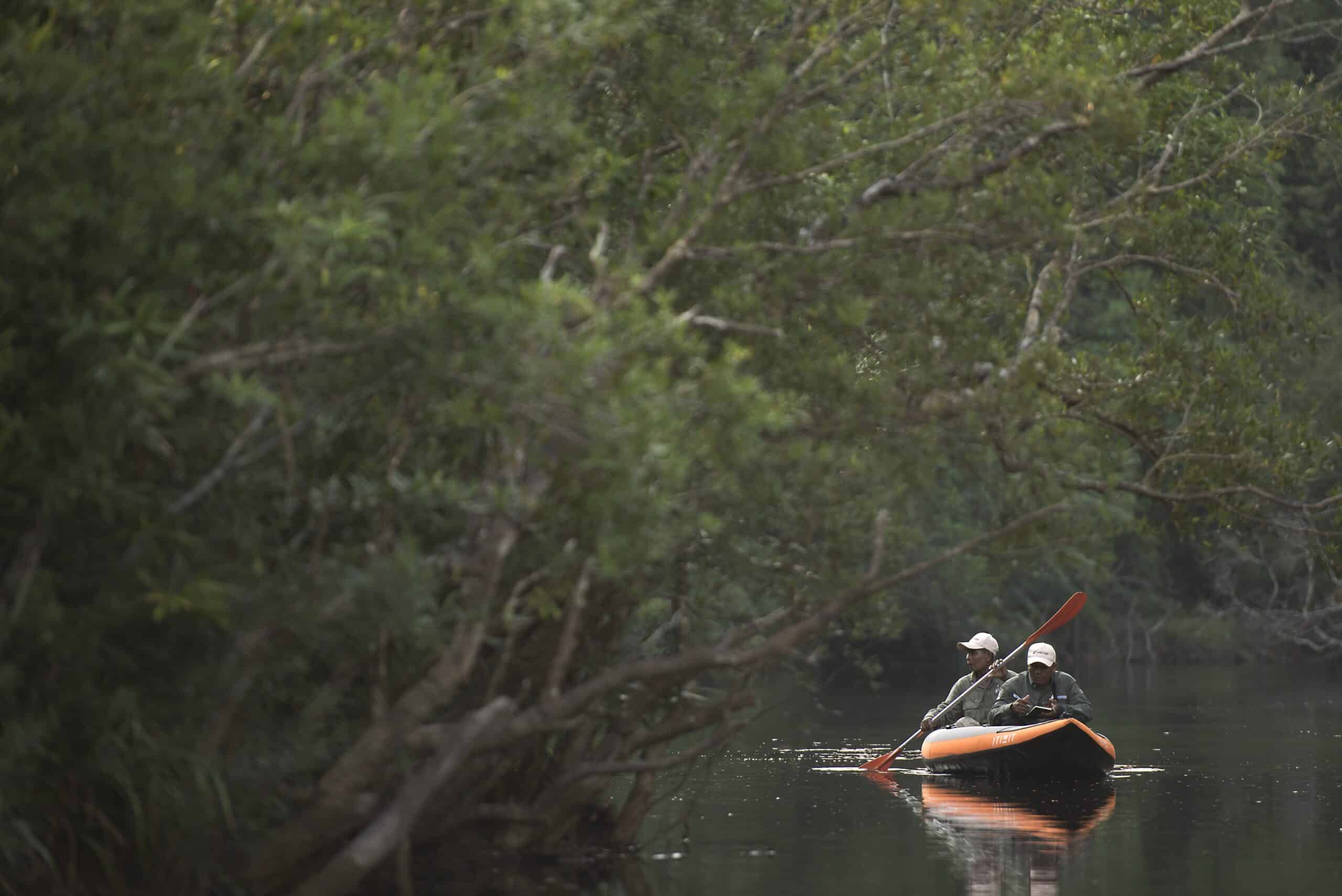
A boat survey along the river at Chhay Reap in March 2022. Photo courtesy of Jeremy Holden for Flora and Fauna International.
The presence of wardens has resulted in zero instances of poaching since 2011, and has further achieved the ecological restoration of crocodile habitats with incredible impacts on aquatic diversity. Monitoring activities have indicated that Siamese crocodile populations across target sites are stable or increasing, and successful reproduction has been reported over various sites.
Other strategies employed by the FFI include: strengthening disincentives for illegal behaviours; providing financial compensation for community scouts and landowners who report crocodile activity (thereby encouraging the protection and conservation of eggs, juveniles or adults who wander into rice plantations or agricultural farms); performance-based incentives for patrolling or guarding practices; raising community awareness about crimes against wildlife exploitation and the associated sanctions; and improving local education and awareness on the importance of wildlife conservation for a balanced, healthy ecosystem.
How Can You Help
- Raise awareness and donate. Organisations such as Flora and Fauna International are working tirelessly to ensure the survival of wild Siamese crocodiles. Inform your friends and family on the plight of the Siamese crocodile, organise a fundraiser, and donate to an organisation that is helping safeguard the species.
- Avoid purchasing crocodile leather products. Since it is impossible to determine whether crocodile leather products imported from Southeast Asia were made from commercially-bred or wild specimens, and due to the generally unregulated nature of the crocodile farming industry in the region, avoid purchasing fashion or novelty items made from crocodile skin.
If you want to learn more about endangered species, make sure to check out other articles from our Endangered Species Spotlight Series










